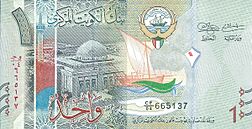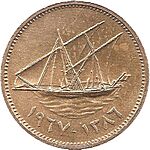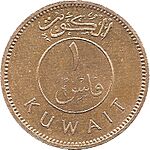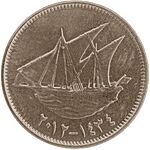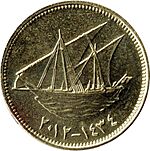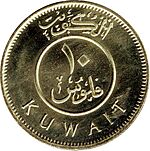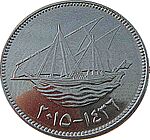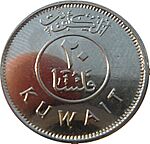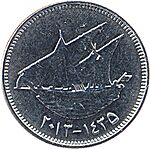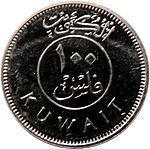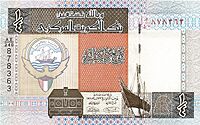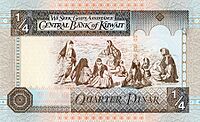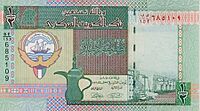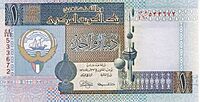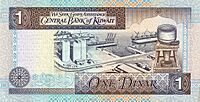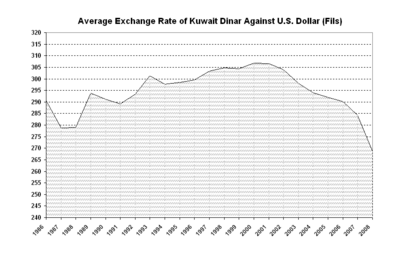Kuwaiti dinar facts for kids
Quick facts for kids Kuwaiti dinar |
|||
|---|---|---|---|
|
|||
| ISO 4217 Code | KWD | ||
| User(s) | |||
| Inflation | 1.50% | ||
| Source | The World Factbook, 2017 est. | ||
| Pegged with | Undisclosed currency basket $1 USD = 0.29963 KD |
||
| Subunit | |||
| 1⁄1,000 | fils | ||
| Symbol | د.ك or KD | ||
| Coins | |||
| Freq. used | 5, 10, 20, 50, 100 fulūs | ||
| Banknotes | |||
| Freq. used | KD 1⁄4, KD 1⁄2, KD 1, KD 5, KD 10, KD 20 | ||
The Kuwaiti dinar (Arabic: دينار كويتي, code: KWD) is the official money used in Kuwait. It is split into 1,000 smaller units called fils.
As of 2023, the Kuwaiti dinar is the most valuable money unit in the world. One Kuwaiti dinar (KD 1) is worth about US$3.26. This makes it more valuable than the Bahraini dinar (about US$2.65) and the Omani rial (about US$2.60).
Contents
History of the Kuwaiti Dinar
The Kuwaiti dinar was first used in 1961. It took the place of the Gulf rupee, which was the money used before. When it was first introduced, one Kuwaiti dinar was worth the same as one British pound.
When Iraq invaded Kuwait in 1990, they tried to make their own money, the Iraqi dinar, the official currency. A lot of Kuwaiti banknotes were stolen during this time. After Kuwait was freed, the Kuwaiti dinar became the country's money again. New banknotes were printed, and the old, stolen ones were made worthless.
Kuwaiti Coins
The coins used in Kuwait were first made in 1961. Their design has stayed the same since then. On one side, you'll see a traditional boom ship. The year the coin was made is also shown in both Islamic and regular (Common Era) dates.
On the other side, the coin's value is written in Arabic. Above it, you'll see الكُوَيت, which means The Kuwait in Arabic. Below that, it says KUWAIT in English.
Kuwait has a special coin worth 0.02 of its main currency unit. This is different from many other countries in the Middle East. The 1 fils coin was last made in 2014.
Kuwaiti Banknotes
Kuwait has released six different designs, or "series," of its banknotes over the years.
First Series of Banknotes
The first series of banknotes was introduced on April 1, 1961. These notes were in use until February 1, 1982. They came in values of KD 1⁄4, KD 1⁄2, KD 1, KD 5, and KD 10.
Second Series of Banknotes
The Central Bank of Kuwait was created in 1969. Because of this, new banknotes for KD 1⁄4, KD 1⁄2, and KD 10 were released on November 17, 1970. The new KD 1 and KD 5 notes followed on April 20, 1971. This second series was taken out of use on February 1, 1982.
Third Series of Banknotes
The third series of banknotes came out on February 20, 1980. This was after Emir Jaber Al-Ahmad Al-Sabah became the leader. This series included KD 1⁄4, KD 1⁄2, KD 1, KD 5, and KD 10 notes. A KD 20 banknote was added later, on February 9, 1986.
During the Invasion of Kuwait, many of these notes were stolen by Iraqi forces. Because of this, the third series was made invalid starting September 30, 1991.
| Denomination | Serial Number Prefixes (Stolen Notes) |
|---|---|
| KD 1⁄4 (د.ك١٤) | 54-86 |
| KD 1⁄2 (د.ك١٢) | 30-37 |
| KD 1 (١د.ك) | 47-53 |
| KD 5 (٥د.ك) | 18-20 |
| KD 10 (١٠د.ك) | 70-87 |
| KD 20 (٢٠د.ك) | 9-13 |
Fourth Series of Banknotes
After Kuwait was freed, a fourth series of banknotes was released on March 24, 1991. The goal was to quickly replace the stolen and old notes. This series helped Kuwait's economy recover fast. These notes were valid until February 16, 1995. They came in values of KD 1⁄4, KD 1⁄2, KD 1, KD 5, KD 10, and KD 20.
Fifth Series of Banknotes
The fifth series of Kuwaiti banknotes was used from April 3, 1994. These notes had advanced security features to prevent fake money. This series was taken out of use on October 1, 2015. The values were the same as the fourth series.
Sixth Series of Banknotes
The Central Bank of Kuwait released the sixth series of banknotes on June 29, 2014. Some of these notes have a rough texture. This helps people who are blind or have low vision identify the different values by touch.
| Sixth series Kuwaiti banknotes | |||||||
|---|---|---|---|---|---|---|---|
| Front | Back | Value | Size (millimeters) | Color | Front Design | Back Design | Release Date |
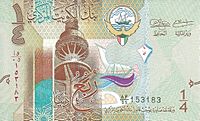 |
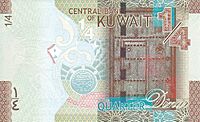 |
KD 1⁄4 | 110 x 68 mm | Brown | Liberation Tower and a dhow ship | Traditional wooden Kuwaiti door and the first Kuwaiti coin | June 29, 2014 |
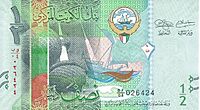 |
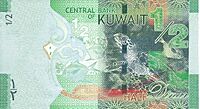 |
KD 1⁄2 | 120 x 68 mm | Green | Kuwait Towers and a dhow ship | Hawksbill sea turtle and the silver Pomfret fish (Al Zubadi) | June 29, 2014 |
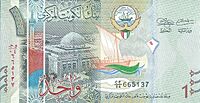 |
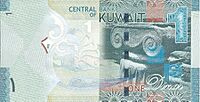 |
KD 1 | 130 x 68 mm | Grey | The Grand Mosque, a bateel dhow ship | Ancient Greek Civilization influences in Kuwait's Failaka Island | June 29, 2014 |
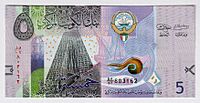 |
 |
KD 5 | 140 x 68 mm | Purple | New headquarters of the Central Bank of Kuwait | Oil refinery and an Oil Tanker | June 29, 2014 |
 |
 |
KD 10 | 150 x 68 mm | Pink | The National Assembly of Kuwait, a sambuk dhow ship | Falcon and camel with a sadu saddle | June 29, 2014 |
 |
 |
KD 20 | 160 x 68 mm | Blue | Seif Palace, a dhow ship | Kuwaiti pearl diver and Al-Boom traditional Kuwaiti dhow ship | June 29, 2014 |
Special Commemorative Banknotes
The Central Bank of Kuwait has also released special banknotes to celebrate important events.
In 1993 and 2001, they issued KD 1 polymer banknotes. These were to celebrate Kuwait's freedom from Iraq. The first one, from February 26, 1993, marked the second anniversary of its liberation. It showed a map of Kuwait and listed the countries that helped free it.
The second special note, from February 26, 2001, celebrated the tenth anniversary. It had a special patch that showed a fingerprint. This was a way to remember the people affected by the invasion. Even though these notes were KD 1, they were not meant for everyday use.
Kuwaiti Dinar Value
From March 18, 1975, to January 4, 2003, the value of the dinar was linked to a group of different currencies. This is called a "currency basket."
From January 5, 2003, to May 20, 2007, the dinar's value was linked to the US dollar. One US dollar was equal to about KD 0.29963.
Since June 16, 2007, the Kuwaiti dinar has been linked back to a basket of currencies. As of December 2016, it was worth about $3.28. It continues to be the world's most valuable currency unit.
| Current KWD exchange rates | |
|---|---|
| From Google Finance: | AUD CAD CHF EUR GBP HKD JPY USD USD |
| From Yahoo! Finance: | AUD CAD CHF EUR GBP HKD JPY USD USD |
| From XE.com: | AUD CAD CHF EUR GBP HKD JPY USD USD |
| From OANDA: | AUD CAD CHF EUR GBP HKD JPY USD USD |
| From fxtop.com: | AUD CAD CHF EUR GBP HKD JPY USD USD |
See also
- Kuwait
- Economy of Kuwait
- Jordanian dinar
- Iraqi dinar


